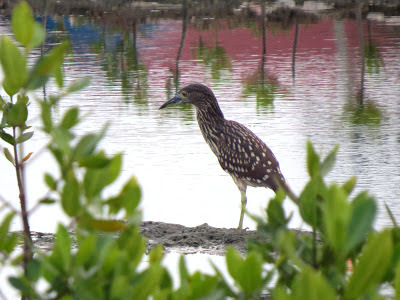After a tiring but super fun morning in the Baluno forest, our group headed back to Zamboanga City to check out the wetlands inside the Zamboanga State College of Marine Science and Technology. We parked inside the campus right beside a huge mound of soil. Ma'am June told us that there was actually a buried Sperm Whale there which was found beached in the area.
 |
| Buried Sperm Whale |
We immediately checked out the nearest mangroves where we saw a lone Common Sandpiper and some Barn Swallows perched on top of bamboo poles. We walked back down the road where we were joined by Dr. Tenorio, the Executive Director for Research and Extension of the ZSCMST. We peeped through the gaps in the mangroves and there were all the birds!
 |
| This "island" had lots of night-herons and some egrets. |
There were waders foraging in the shallow water, mostly Common Redshanks and Black-winged Stilts plus quite a number of Common Moorhens. On the "island" we saw Black-crowned Night-Herons and some Rufous Night-Herons too. Barn Swallows were perched on bare branches looking like fruits.
 |
| One of the three Rufous Night-Herons we saw that afternoon. |
 |
| Lots of perched Barn Swallows |
Then Mike noticed a Great Egret walking in the water. It had peculiar pink legs making it look like a flamingo! We noticed all the other Great Egrets sporting the same pink legs PLUS bright blue-green lores! Lores are the surfaces on both sides of the birds face between its beak and its eye.
 |
| Great Egret with pink legs |
Usually Great Egrets have yellowish green lores but most, if not all, of the birds we saw that afternoon had the same bright bluish-green lores. We were scanning the top of the mangroves for more of these beautifully colored Egrets when I saw three of them, clustered together looking fluffy. Fluffy? Chicks? Chicks!!!
 |
| Fluffy Great Egret chicks extending their necks, awaiting food. There are actually three chicks in this nest. |
I began to take notice of all the birds surrounding the nest with chicks. They were all Great Egrets sitting on nests! It was a nursery! It was really great being able to observe the egrets in a different setting -- Great Egrets are not known to breed in the Philippines! Usually, we get to see them hunting for food or standing still in a rice field. These breeding egrets looked so different, some of them had back plumes that had thick quills and very fine feathers which they were sort of draped over their backs and wings. It sure felt like seeing a lifer!
 |
| Here's one of the lovely couples in their "breeding best" =) |
 |
| Here's another one showing its back plumes while it readjusts itself in its nest. |
We had to leave the egrets to walk to another portion of the wetlands. Most of the ponds were filled with water so the egrets were farther away. In the immediate area though, I saw an immature Rufous-night Heron which was very focused on catching prey. It was nice knowing that they are also successfully breeding even with the presence of the Black-crowned Night-Herons.
 |
| Immature Rufous Night-Heron |
Before it got dark, we were invited by Dr. Tenorio to have merienda prepared by some of their students. Over suman, brownies, and refreshing pineapple juice, we gushed over the birds and the wetlands. The faculty members who joined us were very interested in bringing their students go birdwatching and discover a wonderful part of the own campus. For us birders, we were happy enough with seeing a new side of the Great Egret.

nice! will this years birdfest be held in Zamboanga?
ReplyDelete